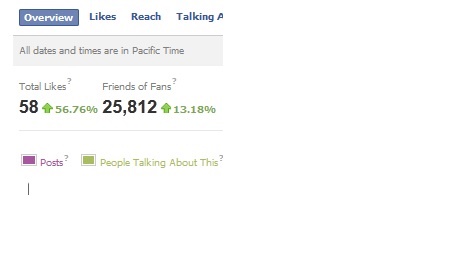Your cart is currently empty!

Are Likes and Follows Your Best Metric?
How many friends do you have at Facebook? If you’re working toward Prom Queen or King, this may be an important metric for you to watch. For your practice? Maybe not.
The screenshot at right shows Facebook Insights from an organization with a fairly small number of Likes: a mere 58. (We appreciate this client’s giving us permission to share this data.)
In the past week, they’ve had 3, 937 visits to their website from Facebook — a significant amount of traffic for their website, which has been live for less than a year and serves a specialized niche market. They had a potential Facebook reach of nearly 26,000 for this time period.
Below you can see a screenshot of a Twitter report for the same website.
They have a small number of Twitter followers, too: 134. That doesn’t keep them from reaching a potential audience of hundreds of thousands.

The point is, while Likes and Follows should increase over time, they don’t predict the value of your social media. You can be reaching far more than the number of people who like you — or you may actually be reaching far fewer.
What do Likes and Follows do for you?
We often see social media accounts with modest numbers of Likes and Followers reach thousands of people with a particular post. This usually happens because influential fans share the post. This is one of the reasons social media can be so powerful — you can reach not just people who already know about you, but also their friends and fans. Usually, this not only gives you additional reach for your message, but it also leads to new followers.
Your number of fans and followers thus increases naturally over time, as long as you provide value.
Growing your fan base gives you a larger audience, as well as a larger potential reach. It makes your practice or organization look legit. It gives more power to your social media ads. Because of these benefits, it makes sense to measure the increase in your Likes and Follows. It often makes sense to run campaigns designed to increase your fan base.
Likes and Follows can be valuable. They’re also very easy to measure, which makes them an alluring metric.
But measuring your success by Likes and Follows can be deceptive. For one thing, those numbers are easy to manipulate. For another, the actions that increase your Likes don’t necessarily improve your business. When you choose Likes for your primary metric, you or your social media team will naturally go with things that get more Likes… not the things that get more conversions, lead to better patient education, and so forth. You’re setting up a target, so you’ll probably work toward hitting that target. You’d be better off choosing a target that aligns with your business goals.
Better metrics
Here are some things you might want to watch, in addition to or instead of Likes and Followers:
- Reach The organization in the example is working on getting the word out — you might call it “brand awareness.” Even if people don’t come to their website or even click through their post to read the articles they’re sharing, their posts and tweets are serving their purpose. How many people are you reaching?
- Traffic The number of visitors brought to your website by social media can be significant, and getting people to your website is usually the first step in lead generation and sales.
- Conversion It’s nice to be loved, but if the thousands who like you don’t buy or otherwise meet your business goals, gathering likes is not doing your business much good. Social media marketing can’t be about the company ego.
- Virality Check your Facebook Insights to see what percentage of the people who see your posts will actually interact with you. Our example organization has virality measurements of 12-22% on a number of their posts this week — very high numbers compared with the average small website, and high for an organization taking a thought leadership approach to social media, as this one does. Some of our chattier accounts see this kind of number regularly, but the average Facebook account is more likely to see numbers around 5%.
- Engagement Overall engagement — retweets, shares, clicks, and responses — can be a good indication of how well your social media efforts are connecting with your audience.
When I discussed this organization’s results with the client, she asked, “What should we do about this?” and then answered herself, “Keep posting interesting stuff, I guess.” That’s basically it: keep doing what works, and change what doesn’t work. Without looking at the right metrics, you won’t know the difference.
by
Tags:

Leave a Reply